One LED flare replaces U.S. required pyros, Sirius Signal but not Ocean Signal
The pitch is compelling. The $100 Sirius Signal SOS C-1001 LED “flare” isn’t just a floating SOS flasher visible at night “up to 10+ nautical miles…for at least 6 hours.” It is also the only such device that meets the U.S. Coast Guard requirements for an electric distress light and can thus permanently replace the three pyrotechnic flares otherwise required on all U.S. recreational vessels over 16 feet operating in coastal waters, the Great Lakes, and many major rivers (and on even smaller boats at night). Given that the cheapest flare set costs about $33 and expires 42 months after manufacturing (and you might not want the cheapest because pyros are inherently dangerous to you and the environment), the Sirius substitute may be a “no brainer”…
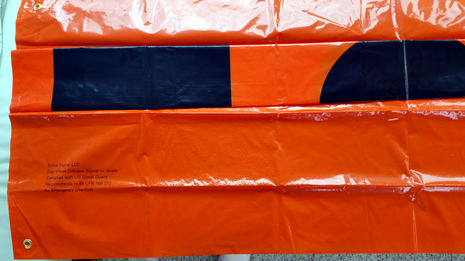 Actually, the $100 Sirius Signal Distress Light kit also includes an orange plastic Distress Flag (sold separately here), so that it completely meets the USCG requirements for day and night visual distress signals. And company co-founder Bob Simons spent 35 years conducting Vessel Safety Checks as a volunteer CG Auxiliarist and reports that the most common failure is expired flares. That, and a partner with manufacturing and lighting expertise, is how Sirius Signal came to be.
Actually, the $100 Sirius Signal Distress Light kit also includes an orange plastic Distress Flag (sold separately here), so that it completely meets the USCG requirements for day and night visual distress signals. And company co-founder Bob Simons spent 35 years conducting Vessel Safety Checks as a volunteer CG Auxiliarist and reports that the most common failure is expired flares. That, and a partner with manufacturing and lighting expertise, is how Sirius Signal came to be.
At any rate, the 36 x 36 inch distress flag seems well made, consisting of two plastic layers sewn together and then brass grommeted so it can be clearly displayed (black square over black circle the preferred orientation).
 The Sirius LED flare also seems well made and quite simple in design (aside from the diode’s little circuit board). There’s only one light mode and to activate it you just screw the lens/cap a turn or two tighter. Being slightly skeptical about this type of “switch”, I shook the deactivated light vertically and even banged it down hard while upside down. But it did not light up accidentally, and I think it remains waterproof in the off mode because there are two well-spaced O rings protecting the ingress area just below the body threads.
The Sirius LED flare also seems well made and quite simple in design (aside from the diode’s little circuit board). There’s only one light mode and to activate it you just screw the lens/cap a turn or two tighter. Being slightly skeptical about this type of “switch”, I shook the deactivated light vertically and even banged it down hard while upside down. But it did not light up accidentally, and I think it remains waterproof in the off mode because there are two well-spaced O rings protecting the ingress area just below the body threads.
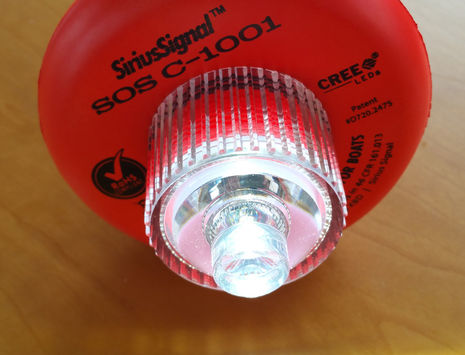 I have not tried this distress light in realistic conditions — that’s tricky, though I hope to eventually figure out a test method that doesn’t confuse anyone — but I can tell you that the single Cree LED and the molded lens combined are too bright to look at closely even in a lit room, and that while the light is particularly focused on the horizontal plane, there’s also a skyward component for aircraft and helicopters. The Morse code SOS signal (· · · – – – · · ·) is also well articulated with effective pauses between the letters.
I have not tried this distress light in realistic conditions — that’s tricky, though I hope to eventually figure out a test method that doesn’t confuse anyone — but I can tell you that the single Cree LED and the molded lens combined are too bright to look at closely even in a lit room, and that while the light is particularly focused on the horizontal plane, there’s also a skyward component for aircraft and helicopters. The Morse code SOS signal (· · · – – – · · ·) is also well articulated with effective pauses between the letters.
Incidentally, MarineBeam — also a source of Gizmo’s beloved Ultra Long Range LED flashlight and white LED running lights — supplied this test sample from their stock, but the Sirius Signal SOS light kit is also available from Defender and other sources.
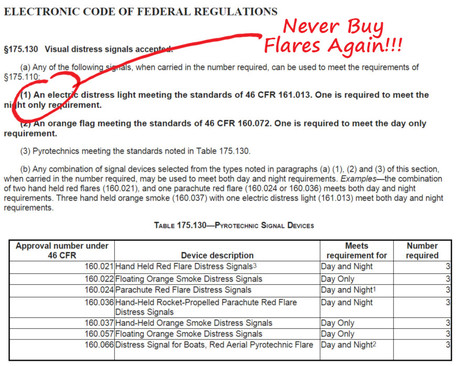 The visual distress signal requirement that Sirius Signal screen captured above can be found in 33 CFR 175.130, which then references 46 CFR 161.013 for the actual electric distress light standards. The requirements seem pretty complicated, particularly in terms of light intensity, but what is obvious is why other existing electronic flares cannot be self-certified by their manufacturers.
The visual distress signal requirement that Sirius Signal screen captured above can be found in 33 CFR 175.130, which then references 46 CFR 161.013 for the actual electric distress light standards. The requirements seem pretty complicated, particularly in terms of light intensity, but what is obvious is why other existing electronic flares cannot be self-certified by their manufacturers.
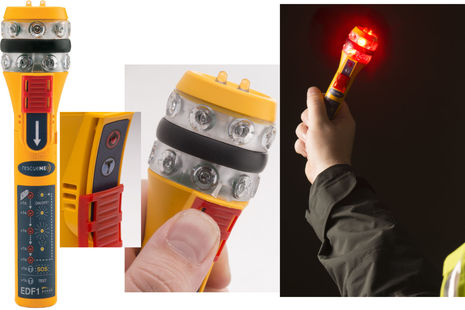 The Ocean Signal EFD1, for instance, looks like a very effective LED distress light. Besides SOS signalling with a “range up to 7 miles”, it has three other useful modes as well as the ability to test the state of its Lithium battery. However, it does not meet 46 CFR 161.013 standards because it cannot “Float in fresh water with the lens surface at or above the surface of the water,” and also because its light is red, not white. Interestingly, though, an Ocean Signal representative recalls that the color red was chosen because it’s “better to distinguish as an emergency signal” and also because red LEDs “have a higher actual light output both measured and perceived.”
The Ocean Signal EFD1, for instance, looks like a very effective LED distress light. Besides SOS signalling with a “range up to 7 miles”, it has three other useful modes as well as the ability to test the state of its Lithium battery. However, it does not meet 46 CFR 161.013 standards because it cannot “Float in fresh water with the lens surface at or above the surface of the water,” and also because its light is red, not white. Interestingly, though, an Ocean Signal representative recalls that the color red was chosen because it’s “better to distinguish as an emergency signal” and also because red LEDs “have a higher actual light output both measured and perceived.”
Which brings us to the point that there may well be a difference between the safety equipment that you’re required to carry and the added safety equipment that makes sense for your particular boating situation.
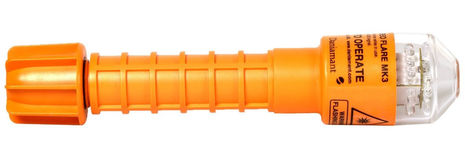 Another LED flare contender then is the Odeo MK3 model above ($185 at Landfall), and let’s note that the Odeo MK1 broke trail in electric distress devices. I was also impressed with ACR’s new Aurora pyro flares when I saw them demoed in Miami, and I think that pyros can be more effective in certain circumstances. The BoatU.S. Foundation has good info on pyro flare types and uses, though I believe I found the final words on visual distress signals in Practical Sailor. Frank Lanier (just Panbo’d here his excellent ICW Guide review) began a review of the Odeo MK2 thusly:
Another LED flare contender then is the Odeo MK3 model above ($185 at Landfall), and let’s note that the Odeo MK1 broke trail in electric distress devices. I was also impressed with ACR’s new Aurora pyro flares when I saw them demoed in Miami, and I think that pyros can be more effective in certain circumstances. The BoatU.S. Foundation has good info on pyro flare types and uses, though I believe I found the final words on visual distress signals in Practical Sailor. Frank Lanier (just Panbo’d here his excellent ICW Guide review) began a review of the Odeo MK2 thusly:
Like winning lottery tickets and accurate head shots during the zombie apocalypse, visual distress signals are one of those things you just can’t have too many of.
PS May 23, 2016: Since there seem to be some who doubt that the Sirius Signal SOS LED device really fufills the “electric distress light” standard that’s been in the CFR for a long time, it’s great that a Panbo reader who is also a volunteer US Power Squadron Vessel Examiner sent in this recent clarification from the USPS Safety Committee:
UPDATE FOR VESSEL EXAMINERS AND Boat Owners
SIRIUS SIGNAL LIGHTVessel Examiners should be aware of the capabilities and approvals of the SIRIUS SOS C-1001 electronic distress light. This light is acceptable as a nighttime visual distress signal.
SIRIUS has included a daytime distress flag in the SOS C-1001 packaging so that it can market the package as a solution for a combined day/night signal, and as a replacement for flares. As long as the SIRIUS Signal Model SOS C-1001 is carried in conjunction with an acceptable daytime distress signal, this satisfies the daytime/nighttime signaling requirement.All electronic visual distress signals, in order to be acceptable, must be legibly and indelibly marked with the statement: “Night Visual Distress Signal for Boats Complies with U.S. Coast Guard Requirements in 46 CFR §161.013. For Emergency Use Only”, and must also be marked with the manufacturer’s name, replacement battery type and lamp size.If an electric light is designed for use with dry cell batteries the label must advise the consumer on the battery replacement schedule, which under normal conditions would maintain performance requirements of 46 §CFR 161.013-3When conducting a vessel safety check, all Auxiliary Vessel Examiners (VEs)and Power Squadron examiners are to check/verify this piece of safety equipment in accordance with the Vessel Safety Check Manual, COMDTINST M16796.8A.


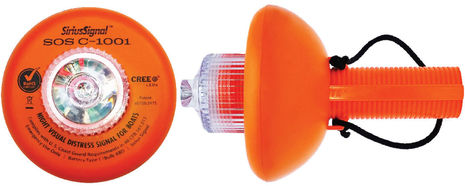
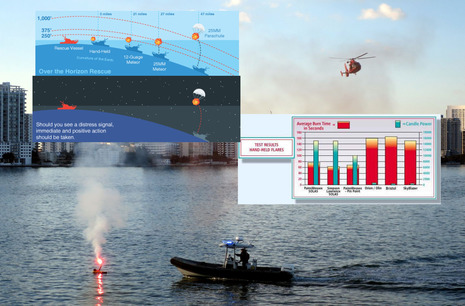
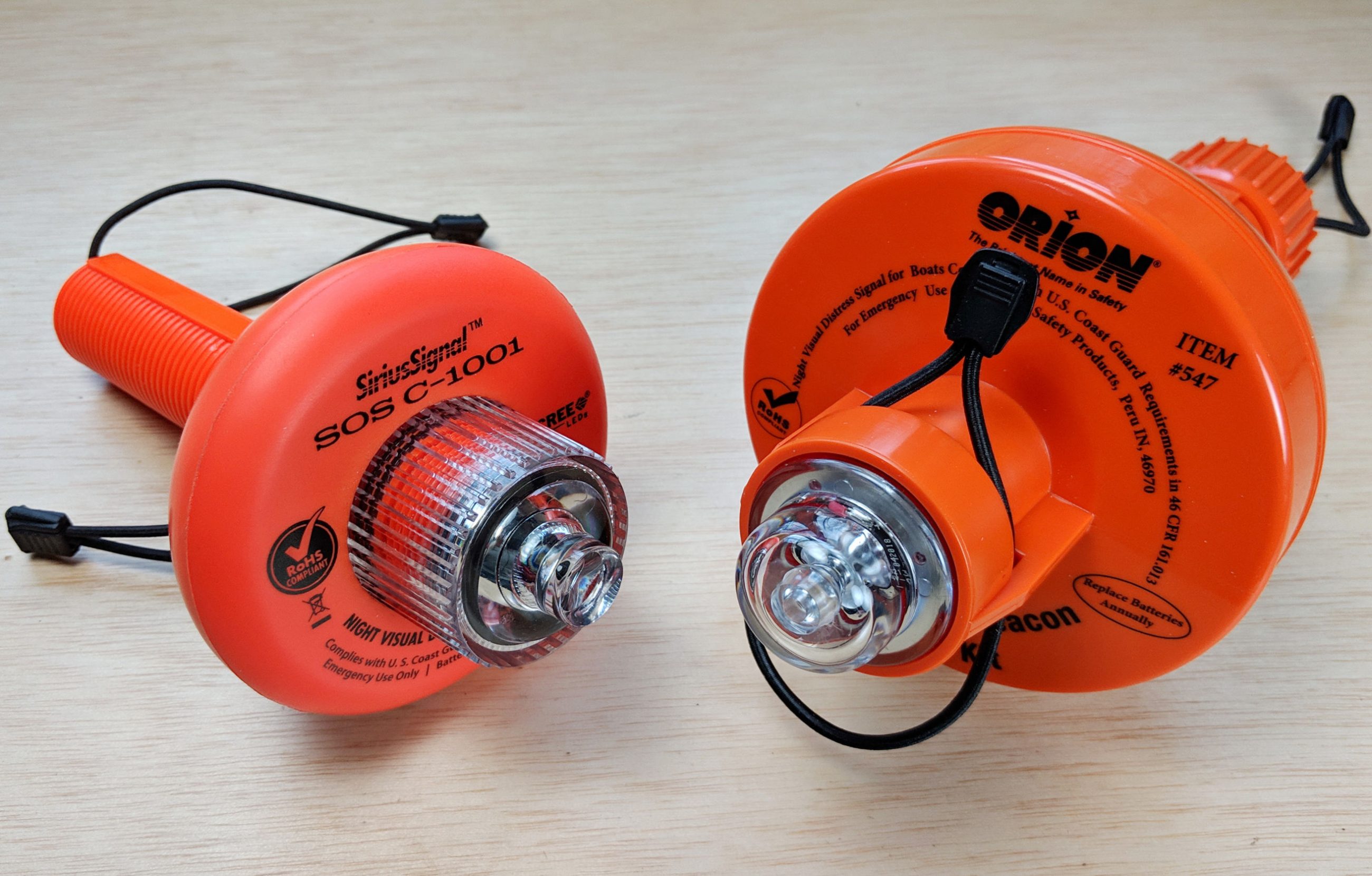
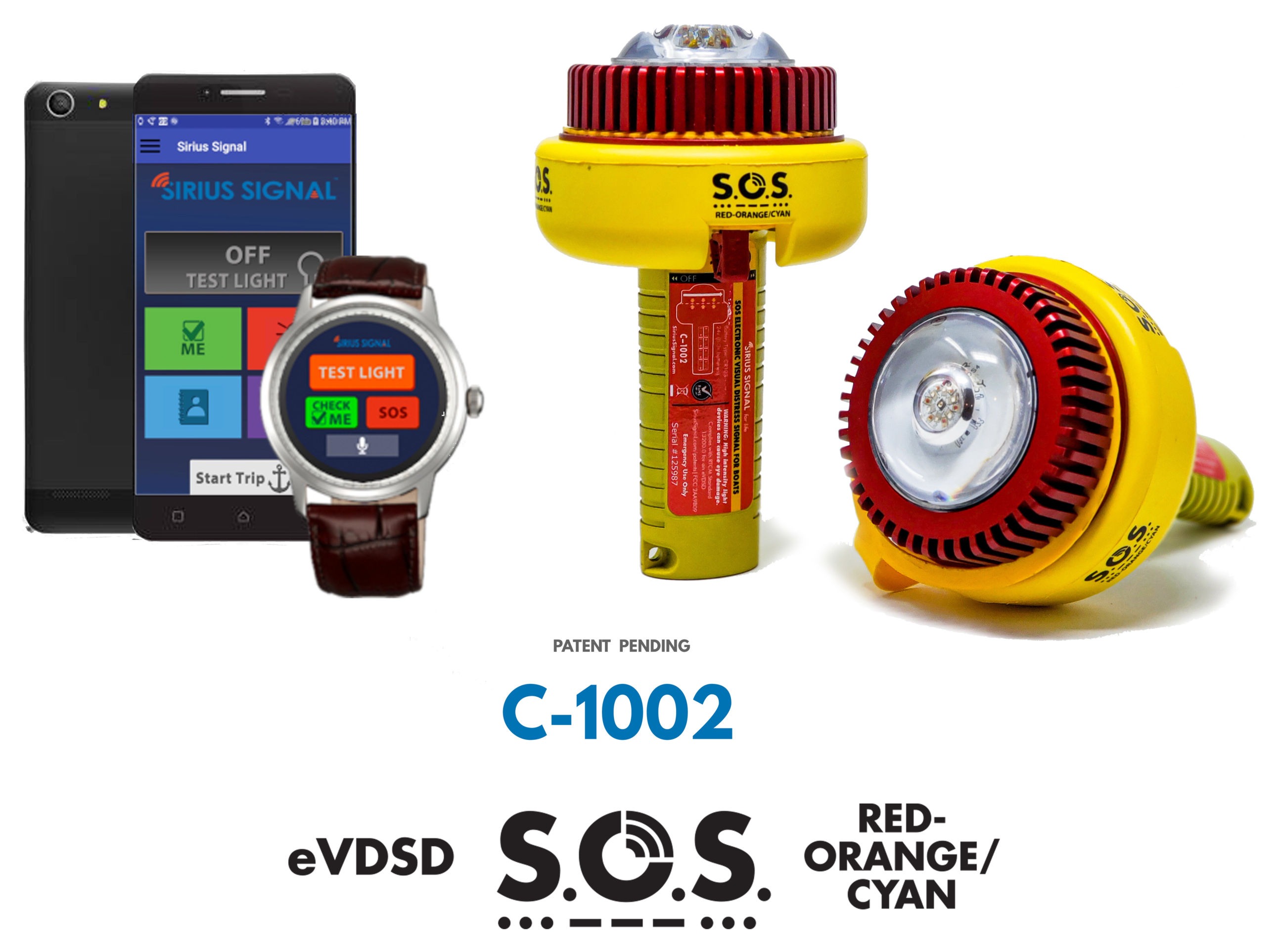
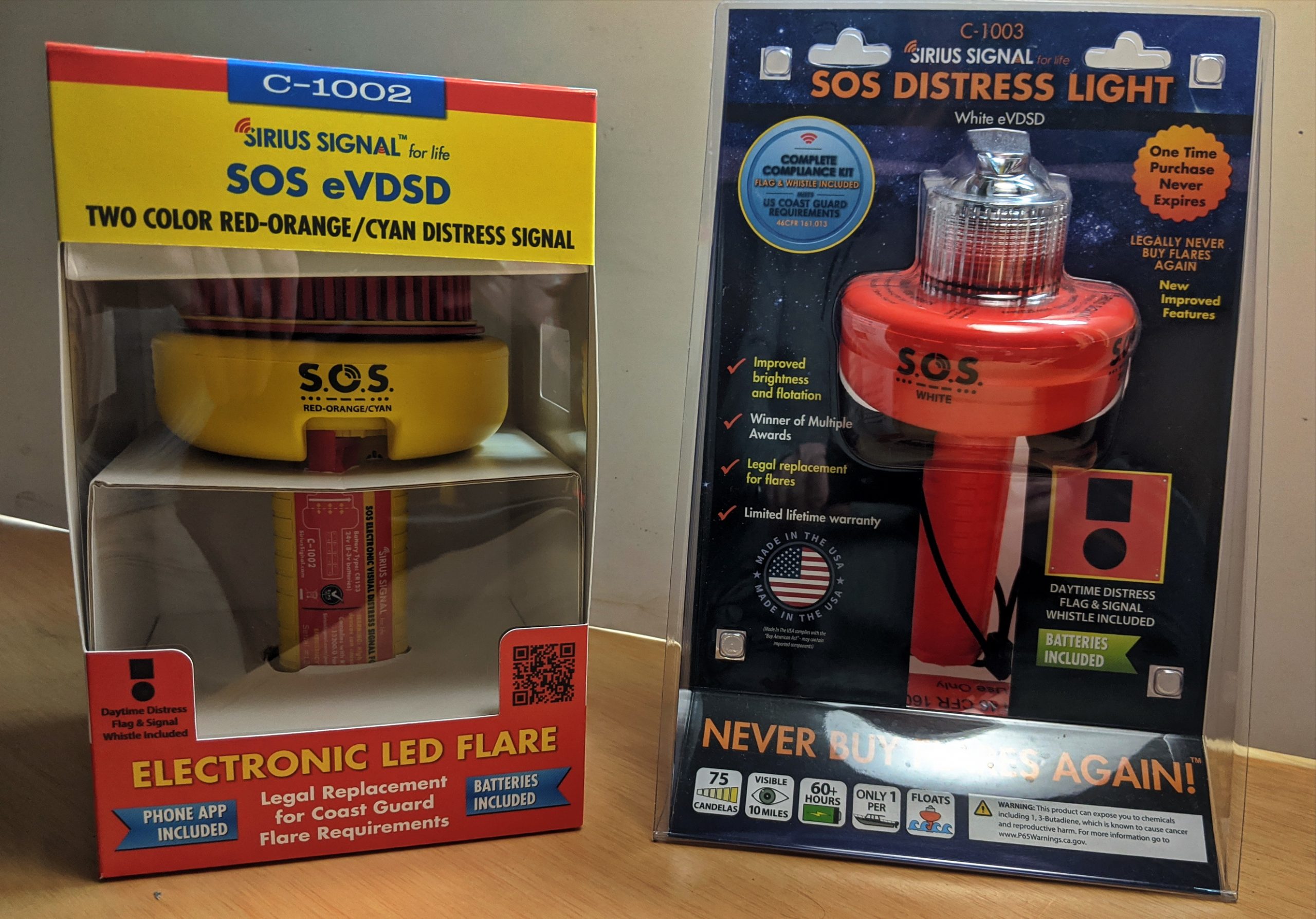








Orion 12 ga. flares are only $22 at Walmart, for a 4-pack.
Their stock is fresh, so you generally get close to the 42 months from them.
LEDs have their use, particularly when tethered to a PFD for MOB use, but in my opinion, if you are really concerned about being seen while still afloat, nothing beats a SOLAS-rated parachute flare, but they are very expensive, and do expire. I have only one, in a waterproof Pelican box, supplemented by the Orion 12 ga.,
and a Fenix high lumen LED flashlight (with SOS mode) tethered to my inflatable PFD.
Once you meet the minimum USCG requirements, all else is just frosting on the cake, and if stored properly, most expired pyrotechnics still function as back-ups.
And, any aerial flare will attract more notice than one at water-level, especially in bright daylight. Just my opinion.
Thanks, Karl, but let’s clarify that you need to buy a flare gun kit at about $50 to use the 12 gauge flares.
I agree that parachute flares are great, but not sure about “if stored properly, most expired pyrotechnics still function as back-ups” This piece suggests that 50% of expired pyros don’t work right:
http://www.boatingmag.com/problems-pyrotechnics
We accept expired flares in my USPS squadron and use them as training aids. We set them off (with Coast Guard permission) for training classes.
Contrary to what “boating mag” says, I’ve never had an expired flare fail to perform. Some of them were over 10 years old.
Thanks for the great post.
My biggest concern would be leaky/faulty batteries. They tend to leak, especially when stored and destroy the contacts. Is that plastic cup holding the electronics act as an isolation and protection device?
Flares certainly get the most attention for distress purposes but they also are very dangerous and are difficult to deploy in certain circumstances. I welcome a good alternate distress signal that meets the USCG requirement.
Cheers,
William in Miami.
Ben,
A lot of people agree with you. Defender had the Siris Flare as their Active Captain special a few weeks ago. Defender sold out in 24 hours. They received more stock recently (and shipped mine).
My biggest concern about the Siris flare is the c-batteries. I have had too many flashlights destroyed by batteries that have leaked. Many flashlights aboard are stored with the batteries in a zip lock bag next to the flashlight. I am not sure how I will keep the Siris.
I can’t agree more with HenryD. On our boat all flashlights are certified dive lights. The small ones cost $100 each and in the past few years two lights have been destroyed by leaking Duracell “C” batteries that were only a year old. I’ve also had other battery operated devices ruined by leaking batteries like a temperature monitor for the refrigerator and small incandescent lights on the life jackets. I date all batteries with a black magic marker when installed. Last spring I started to replace all batteries, whether they need it or not, with new ones annually.
I welcome the new SOS, Siris Flare, but I think until batteries are improved they remain the Achilles heel for the light. Storing batteries in a zip lock bag is not going to help much in the middle of a stormy night when you have less then a minute to get off the boat. But, right now it remains the only alternative.
This is one time I’m going to wait for the second generation.
Well, head’s up, that’s three informed concerns about leaking C batteries!
I examined the innards again and the electronics “cup” does not completely isolate the circuit board from the batteries. There are 4 holes toward the center of the cup bottom that may be intended for ventilation.
On the other hand, the positive end of the battery stack is kept fairly far from the cup by the head of the brass bolt that serves as the + contact and also holds up the LED. And the light tends to rest tilted up due to the float collar. I think it would be hard for battery acid to do damage, though it certainly makes sense to remove the C cells during the off season.
Has anyone tried using AA-to-C size battery adaptors and Lithium AA’s to avoid leaking problem?
http://goo.gl/0O8b32
I’ve asked the Sirius Signal folks what they think of this idea.
Panasonic makes a Lithium C battery
http://industrial.panasonic.com/ww/products/batteries/primary-batteries/lithium-batteries/cylindrical-type-lithium-batteries-br-series/BR-C
I have a dry pilot house. The consistent hassle of pyro flares is why I am excited to see these products come to market. No need to light a fire on a sinking ship is another.
Howard, it’s 3 volt, not 1.5. Lithium “C” seems to be a size only denomination (and has probably caused some problems ;-).
Thanks for pointing that out…
I would hope that Sirius would engineer their product to use a long shelf life battery, possibly to accommodate the 3volt cell.
On the other hand, replacing a few alkaline C batteries is easier and cheaper than 42 month flares. I would happily replace the alkaline batteries every year.
Aha! Sirius Signal is serious about battery leakage. Check the dissembled SOS light photo above and note the little black box glued to the inside of the electronics cup. That is a platinum catalyst meant to protect against the out gassing of a failing alkaline battery, and Sirius is purportedly spending 88 cents per unit to take that extra step.
I just spoke with Anthony Covelli — the Sirius “partner with manufacturing and lighting expertise” — and a lot of thought went into the power design. Covelli tries to avoid proprietary or hard-to-find batteries on his own boat and he points out that alkaline C cells can be found all over the world. He also said that the Rayovac brand batteries Sirius includes has a low failure rate.
Thanks for tracking this down Ben. I also got the Defender Active Capt. deal. I’ve been storing the light in a baggy which also holds the batteries in a separate baggy because of corrosion concern.
Cheers
We have converted to AA NIMH batteries with adapters for all our flashlights. $22 for a pack of Eneloop 10x AA and 6x AAA and charger at Costco. I’m sure the Lithium AA primary batteries (1.5v) would work really well.
http://www.batteryspace.com/primary-lithium-battery-energizer-aa-1-5v-3000mah-ultra-capacity-l91vp-non-rechargeable-4-5wh-2-0a-rate—un-38-3-passed.aspx
It’s interesting that the Coast Guard doesn’t appear
to require dated batteries as they do on required
PFD lights, EPIRBs and such for commercial users. Since pyro’s are
dated, it would seem that the lights would have a similar requirement for the batteries to assure their functioning.
You can test a battery and know it’s good or bad. You can’t test a pyro without firing it.
Hi Ben,
I have one of the SOS Lights from Sirius Signal and I tested it at night off my dock on a line for about 5 minutes and I was impressed with the performance from about 100 yards. It was very noticeable. I also left it on indoors all night with a cloth cover over the bright light and it was going strong in the morning. I am done buying flares. Peter
Anybody happen to know if these are legal in Canadian waters? If not, could be a potential problem for US boaters heading north without any conventional flares onboard.
Good point, Boydster, and according to a Sirius Signal post at eBoatCards “We are in process with Canadian officials on Type Approval and Use. Updates will be forthcoming.”
Boydster, the equipment requirements are usually based on the country of registry, and not where the vessel is operating. Here is an excerpt from the Transport Canada site:
“Safety Equipment Requirements
Foreign pleasure craft (pleasure craft that are licensed or registered in a country other than Canada) need to comply with equipment requirements of the country in which the vessel is usually kept.”
Count me in as excited about reducing the amount of pyrotechnics aboard!
That said, I have a beef with the article you referenced, Ben. They claim (based on one activity they witnessed) that “50% of outdated flares are duds” – without indicating how old those “duds” were, what brand they were, or how they had been stored! I inherited a number of outdated flares with our first boat (in 1994) and I trucked them home to AZ. I’ve since brought a number more from my boat, keeping only the newest of expired ones aboard. I then shot the old ones off when I could arrange proper weather (generally in a snowstorm at our cabin in N. AZ). What I found was that aerial flares more than 10 years out of date tended to malfunction roughly in proportion to their age – the 20+ year old ones were not worth having around, but 10-12 years old were way better than 50%. Newer than 10 years old were at least 95% good. Handheld flares were almost always good, even the ones that expired in the mid 80’s!
Brands? Mostly Orion, Olin (12 ga flares) and Pains-Wessex. Some of the earliest ones were something else, but they’re long gone and I don’t remember.
This is a very interesing development, and I am very tempting to buy one of these, if only because they can actually be tested to see whether they work without rendering them useless.
I once did a “test” on a bunch of expired pyrotechnics in the Annapolis area on the 4th of July. There were so many other pyros going off that mine could not be interpreted as a distress call – I figure that thousands of boaters-in-distress probably die each 4th of July in the Annapolis area because their pyro distress signals are not detected.
If I remember correctly, I fired off about 25 12ga flares, which were 1-12 years out of date, and only 2 failed to fire. They were not the oldest ones.
When I lived in France, we lived in mortal fear that the French inspectors would haul us off to the Bastille for carrying expired flares, until we asked one of them about safety issues, and he explained that he could not inspect our boat for safety because we were registered outside the EU – he could only inspect us for tax compliance.
In any case, I think this is a good way for new electronics to go. BUT, I will still carry pyros – the very expired, very expensive, never used SOLAS parachute flare, a bunch of 12ga shells (illegal to purchase in the UK), and a large bunch of both French and US hand flares. Periodically I take a few of the oldest hand flares and test them in my back yard – none have ever failed. I had not heard about the 12ga’s at Walmart – it sounds like a good source to keep up the stock.
Is there a reason for white light since COLREGS Annex 4 states that a distress signal is a RED flare and not a white one?
All the other LED flares are done RED and not white as COLREGS requires..
Buoys use red and green blinking lights to identify the buoy on charts at night.
A WHITE flashing light would get more attention than a RED flashing light on the horizon.
I don’t pay much attention to green or red flashing lights on the horizon because I assume they’re the buoys marking the Beaufort Channel. If I saw a white flashing light It’d stand out. There’s a few “white lights” out there, from boats and stars and marinas and beach campers and such, but none of them blink.
Coming out of Beaufort inlet there’s about 8 buoys with red flashing lights on them. None of them flash white. If I had to be distracted long enough to watch 8 buoys and decide if it was a . . . – – – . . . flash rather than the buoy identification flash, I’d be pretty distracted while boating at night.
I think the idea was that a flashing white LED is rare and more likely to be an SOS than a red flashing LED, which is most likely to be a navigation buoy.
What Karl said: “LEDs have their use, particularly when tethered to a PFD for MOB use, but in my opinion, if you are really concerned about being seen while still afloat, nothing beats a […]”
PFD or MOB lights are good, but when you really really want to be rescued, nothing beats an EPIRB or PLB.
It’s time that the writers of the Regs realized that flares of any type only work if there is someone else nearby to see them AND they happen to be looking at that moment. They could work in a busy harbor for example, but when you are alone out there, their best use is when you can already see the rescue craft coming. And even then I would rather have a laser “flare”.
The money required to be spent on flares would be better spent on the alternatives.
I just got a Sirius yesterday. I still intend to keep pyrotecnic flares on my boat, in particular the SOLAS parachute flares and SOLAS smoke flares. The Sirius will supplement these and will be good insurance against forgetting to renew the flares and being boarded by the Coast Guard.
I forwarded that very question to CCG as a past Squadron Training Officer and past Regional Training officer for CPS Mainland District about 3 weeks ago. The only response I received was a generic acknowledgement of receipt and that someone would reply shortly.
Personally, I have ordered one and will keep it in addition to my required Canadian pyro requirements.
I don’t know much about marine electronics but I know words. And I had to come and say that next time you hit publish on a similar article that you make the title more like
“It only takes ONE LED Flare to replace Pyros. Siriusly!”
Probably doesn’t make sense anymore but we’re talking puns here man! Making sense is arbitrary
Are flares required anyway for SOLAS compliance?
Nick, U.S. recreational vessels do not have to meet SOLAS requirements. The definitions are complicated but basically SOLAS only applies to certain commercial vessels, usually over 300 gross and making international voyages:
http://www.imo.org/en/OurWork/Safety/Regulations/Pages/Default.aspx
The USCG also has separate safety regulations for non SOLAS vessels like small passenger vessels:
http://www.uscg.mil/pvs/SPV.asp
When I was at the Annapolis Boat Show I looked at a running display for the SiriusSignal LED flair. My first impression and gut feeling was that this is a nice product, a very good idea, legal, but not quiet developed to perfection. Maybe I’m mistaken, but I thought I saw the LED flash in a sequence a little off from the traditional SOS, (…- – – …). To my eye it looked more like the SOS sequence repeated without a proper pause between the last S and the first S in the light signal. Another words I think what I saw was an SOS run together a little too quickly to be immediately recognized as a distinct distress signal. I had every intension of buying the SiriusSignal, but after seeing this decided to hold off through the winter and see if the product improves by spring.
One suggestion for improvement: If in fact the Red LED’s have a higher light output why not have two LED’s alternate the SOS flash. One flash sequence in white, to meet the USCG requirements, and the next flash in red to save your life. Not only would this be an improvement, but it would also display a clear, unmistakeable SOS, alternating Red, White, Red, White, to any observer. The more intense Red LED would be easier to detect and at a greater range.
Thanks, Richard. I did not notice a lack of definition between SOS strings, but will check my test Sirius when I get home. As for your red idea, I don’t think that they are allowed to show anything but white by the current standard.
However, I’ve learned that the USCG is considering a new standard for electric distress lights and the color may be red or even blue. Here’s a report discussing initial testing:
http://oai.dtic.mil/oai/oai?verb=getRecord&metadataPrefix=html&identifier=ADA614755
I believe that Sirius Signal, ACR, and other companies are on the committee that’s still working on the first draft of a new standard, and it will probably be a long, long time before we see LED flares built to it.
Ben, thanks for the link to the R&D Report on ” Alternatives to Pyrotechnic Distress Signals”. Page 9 has the specifications for the time sequence between SOS letters and also says there should be 3 seconds between the end of an SOS and the beginning of the next one. When I was at the boat show I definitely did not see 3 seconds between SOS groups of flashes. Would a low battery be the reason?
Nice to hear the researchers are continuing to refine what is a good start to LED distress devices.
Though I would be very enthusiastic to get the pyrotechnic hazmat off my boat, this has been bothering me:
Conclusions:
“This work strictly pertains to a visual signal (i.e., viewed by the unaided eye). Since U. S. Coast Guard rescue aircraft normally conduct nighttime searches using NVIS with “minus-blue” filtering,” additional research and testing may lead to the inclusion, of an additional flashing signal, with signal wavelength closer to the NVIS central response range, approximately 750-800 nanometers the LED alternative”
I remember reading about the rescue of some New Bedford fishermen off Cape Cod some years ago. The Coast Guard searchers complained about how hard it had been to find them with their night vision goggles because they were all wearing full “Gumby” exposure suits. The neoprene of course blocked all infrared emissions except from their faces. (And saved their lives in the cold water at the time)
To have any validity at all you would have to test these LED’s with night vision goggles outdoors in rain fog and spray to see what the results are.
SOS LED flare kit for $90, shipping included, but today only:
http://www.bluewaterweb.com/p-52630-night-visual-distress-signal-and-flag.aspx
I was recently a passenger in an airliner, looking out the window. We took off shortly after dark and were climbing over suburbia when the plane was “hit” by a green laser. That certainly gets your attention! If I was on a boat and needing to attract attention, that would be what I would want. The disadvantage is how accurately it needs to be aimed. If something else provided almost as much brightness but was less demanding about aiming, that would be good too.
So after that, I had time to think about what lights attracted attention from the air, and the answer was only flashing ones. And most lights are white or white-ish, so those are not the ones which stand out.
I think this article makes a good distinction. Attracting attention has two phases with somewhat different requirements. If the searchers are looking for you already or if you are declaring an emergency.
http://www.cruisingworld.com/how/electronic-vs-traditional-flares
Thanks, Norse. That article by Earl MacKenzie is excellent IMHO. He and I discussed testing the Sirius Signal (and other devices) together, but haven’t made it happen yet.
I did test the Greatland laser flares many years ago and agree with all that Earl reported. Note that they are easier to aim than you might think because the light is shaped into a vertical beam:
http://www.greatlandlaser.com/how-they-work/
Note too that flashing a plane with a laser is quite illegal, UNLESS you’re in an emergency situation.
I decided to purchase the Sirius Signal to try measuring the separation between each burst of SOS signals. The separation is supposed to be 3 seconds, SOS…SOS, etc. Measuring the three seconds with a stop watch is not easy but based on my observation It seems like less then three seconds – just slightly so. Even if I’m wrong and it does meet the three second specification it’s not enough time separation for someone out on the water who is not expecting to see a distress signal to immediately say, “that’s an SOS”. I fear it might be just mistaken for some random flashing light. For the next generation of this product I would suggest a little longer pause between the group of SOS flashes. At least four or five seconds will make the signal unmistakable. Doesn’t seem like much more but I think it will make a big difference.
In any case, I’m glad I purchased the Sirius Signal. Now I’m legal even if some flairs are not exactly in date.
Great news about Sirius Signal: the company has partnered with Weems & Plath, which will now handle the product manufacturing and marketing. It’s a major endorsement of the Sirius Distress Flare concept, and I suspect that it also means that the Sirius team can now focus more energy on new product designs. Press release:
Weems_n_Plath_partners_w_Sirius_Signal.pdf
I can’t disagree more!
This article is wrong and giving out false information.
This item is not USCG Approved
This item is USCG compliant- only
Every USCG approval comes with a certificate and a number for each individual item.
Do NOT throw your flares away, you will get a ticket from the real USCG!!!!
The article states the Owner spent 35 years conducting Vessel Safety Checks as a volunteer CG Auxiliarist- The USCG Aux is a pretend service. The USCG AUX is not allowed to ticket you nor board your boat without permission from you. The USCG Aux make safety recommendations- only and do presentation to elementary schools.
The USCG Auxiliary has ZERO jurisdiction on any water way!!!
I am prior USCG who worked for a 3 star Admiral
You don’t have your facts straight, Phil. What Sirius Signal claims is that SOS C-1001 LED flare “meets the U.S. Coast Guard requirements for an electric distress light” and can thus permanently replace the three pyrotechnic flares otherwise required on all U.S. recreational vessels over 16 feet operating in coastal waters, etc. Formal USCG Approval of an electric distress light is not possible for Sirius or any other company because the USCG has not established a formal approval process, as you can verify here:
https://cgmix.uscg.mil/Equipment/Default.aspx
But the CFRs shown and linked to in the entry are very clear that an “electric distress light” can meet the night time requirement usually fulfilled by pyrotechnics if it meets the detailed standard also linked to above. No one has suggested that the Sirius distress light doesn’t meet that standard, and I’m quite sure that the USCG would speak up if they thought it didn’t (and I would certainly publish that information).
In short, I think that your claim that the USCG will ticket a boater with only a Sirius distress light is completely bogus.
As for your slam of the USCG Auxiliary, well that’s even more mistaken than your understanding of how USCG requirements work. In my 50 years of boating I’ve never thought that the Auxiliary folks were pretending to be anything they are not. Of course they are volunteers — how nice of them — and of course they don’t have any judicial authority, they’re a volunteer auxiliary. They just try to help the Guard and boaters, and I believe most everyone in both groups appreciates their efforts.
http://join.cgaux.org/ben.php
My understanding is that USCG and Canada are reciprocal with regard to safety requirements.
Having been with the USCG Aux. for thirteen and being a vessel examiner I believe this to be the future.
Also, incredibly, one pyro flare can contaminate 240,000 gallons of water.(Believe it!) This has not been mentioned at this time.
Flares are very dangerous!
UGLY RUMOR Dept: Apparently Orion Flare salespeople are claiming that the Sirius SOS distress light will soon lose its USCG approval. That’s simply not true as best I can determine, and I will publicize it ASAP if it is true. In the meantime, please pass this around.
Does Sirius Signal have any comment on this?
If true it would imply a total recall of all product sold. What a nightmare! Did Orion Flare mention what aspect of the Sirius Signal is out of compliance with the C.G. specification? I’m sure they know if they are spreading this rumor.
The rumor is NOT TRUE, Richard, not even close. This morning I spoke at length with Weems & Plath but only got more evidence of what I’d already concluded. The USCG thoroughly approves of the Sirius SOS distress light, if there is an update of the standard it is many years away, and even then existing distress lights will most likely stay approved.
Orion Safety may be doing what’s nicely called “guerrilla marketing” to retain pyro sales, but apparently it’s sporadic and it’s not working. The Sirius light has won several innovation awards, much of the boating public seems to understand what it is at this points, and many thousands are going on boats right now.
In fact, I wish I hadn’t mentioned the rumor, though it may be the ugliest example of purposeful misinformation I’ve ever seen in our gear world. If I do feel the need to write more about it, it will be long and with documentation.
And, please, if you hear anyone repeating the rumor, assure them that it’s false.
Is it really true?
However, last comment indicating it is not true.
What is NOT true, Rosea, is the bull that Orion has spread around.
What is true is that the Sirius Signal LED flare meets the USCG standard for an electric distress signal (and according to Weems & Plath, the USCG is pleased to see it available).
What is also true is that I should not have mentioned Orion’s rumor making as it just confused people 😉
Both insurance companies and marine surveyors do not know about Sirius Signal LED flare and its USCG approval. I had a survey done three weeks ago and was dinged for not having current pyrotechnic flares on board. My newest expired in 2015. The Sirius Signal SOS I showed the surveyor was not even considered. Since my expired pyrotechnic flares were noted as a deficincy in his report my insurance company, ACE, now insists I buy new flares in order to maintain my insurance. When faced with a fight to change the policy of an insurance company, it may just be easier to buy three new flares and be done with it. I have a feeling insurance underwriters have their noses in statistics and have no idea what boats are all about or the change in signaling technology. Certainly they are not reading Panbo.
Geez, Richard, that’s a sad state of affairs. My insurance surveyor was quite interested to learn about the Sirius Signal electric distress signal. He photographed it and I’m pretty confident he looked further into it before writing his report.
CFR 175.130, screen image above, is quite clear that 1 electric distress signal is acceptable night only in lieu of 3 pyrotechnics, and no one has argued that the Sirius Signal does meet the CFR definition of an electric distress signal.
Meanwhile, Weems & Plath is selling thousands of them (and may be sold out). Surveyors and insurance companies don’t have to read Panbo to understand what is going on here…
http://www.weems-plath.com/Products/Safety-Products-1/SOS-Distress-Light-Electronic-Flare.html
http://www.defender.com/product3.jsp?path=-1%7C135%7C2290132%7C2290134&id=2896900
http://www.westmarine.com/buy/weems-plath–sos-distress-light-electronic-flare–17466988
http://www.boatingmag.com/weems-and-plath-sos-c-1001-distress-light
http://www.oceannavigator.com/Web-Exclusives-2016/New-SOS-Distress-Light-Electronic-Flare/
https://www.youtube.com/watch?v=Qk-fiO3uCfk
Interesting comments. It appears that many marine surveyors will need to be educated.
Coincidentally, I am a USPS Vessel Examiner and recently received guidance from the USPS and Coast Guard regarding the Sirius Signal LED. They clearly stated that the LED flare meets the requirements for night signalling devices. Moreover, they stated that the orange flag usually included with the LED flare meets the day signalling requirements.
A big thanks to Norton Rider, who sent me the USPS Safety Committee text he referenced above. I’ve added as a PS to the entry.
Here’s hoping that BoatUS and similar organizations update their safety gear online information in a similar way.
Yes, it’s odd that the “electric distress signal” has been a approved option for many years but no one figured out how to manufacture one in a practical way until Sirius Signal came along. But can’t we all get over our inertia now?
Here’s a hint for Sirius Signal or anybody else, including those that write the rules. There are waves out there, possibly even when and where there is an emergency. Waves obscure things floating on the water. If that thing was a person, a light like this on top of an MOB pole would be great, but make it salt water activated (no switch to forget to set in panic).
I’m not convinced about the orange distress flag. It may be useful in certain situations, but as a general distress call, it’s a Hail Mary.
Hi Norse,
I’m thinking that most visual distress signals are “hail mary” in daylight. Pyrotechnics aren’t particularly visible at a distance, smoke can get blown away or mistaken for other things, flags and mirrors are routinely ignored by most boaters who aren’t looking for them. IMHO, something involving radio (handheld radio, AIS distress beacon, etc.) are a far more reliable bet.
I would say that visual distress signals are “hail mary,” day or night.
Having said that, they have been proven to work. Just last year there was a whale watching boat that capsized in daylight, in Tofino, BC. A crew member managed to to get a flare off and it was spotted by a local fisherman who radioed in a mayday and set off to rescue survivors. Here’s a case where a flag or an LED flare would probably not have worked.
I personally believe in covering all bases. I carry a Sirius LED Light, an orange flag, and a selection of SOLAS and non-SOLAS pyrotechnic devices.
I would agree, Norton! Carrying more than one option in signalling seems a really good idea to me, too.
One thing I’d like to see the USCG do is clarify that it is NOT a violation to have expired flares on board as long as you have the requisite number of in-date ones available. My research (shooting olde flares in snowstorms while a looong way from the sea) seems to show that even 10 year out-of-date flares are pretty much reliable – IF they are properly stored.
The TSB report on the Leviathan II near Tofino is not yet completed or public, but the distress signal aspect is known: “One life-raft was deployed and at least two flares and one parachute rocket were fired.” What is not said is when the flares were fired. All reports say the capsizing was extremely quick — everyone was thrown into the water (except one trapped in the boat), so I expect that the flares were part of the kit of the automatic life raft. It would have been good if it also had a waterproof VHF.
There is a TSB report online from a 1998 whale watching incident in Tofino which makes interesting reading. In that incident the flares were aboard the boat but unreachable since everyone had been thrown into the water. One whale watching group recommends carrying three flares in the pocket of the operator’s floater suit. Again, a waterproof VHF would also be good.
All well and good but how many boaters out there know what an LED flashing SOS means? Most know what a flare means.
Since it’s common for LED flahlights to be SOS capable, and since SOS is famously historic, I would worry more that it was taken as a prank.
Here’s a search in the Boston area with a happy ending. Everyone is happy to credit a Bic lighter, without I hope forgetting the 3 hour air and sea search by the USCG.
http://www.uscgnews.com/go/doc/4007/2857130/
http://boston.cbslocal.com/2016/06/21/coast-guard-couple-rescued-cohasset-rafting-rocky-beach/
http://m.wcvb.com/news/couple-missing-off-coast-in-raft-rescued/40151256
8 miles offshore in THAT!!!
The USCG probably doesn’t require dated batteries because, unlike flares, this device, and the batteries in it, can be tested.
Date codes on batteries are notoriously unreliable, with many batteries being weak or dead years before their date codes would indicate that their service life is over.
That this electronic distress signal is superior to pyrotechnic flares is a fact, not a point for discussion. To suggest otherwise is as silly as arguing that Ford Model T kerosene headlights are superior to modern LED headlights.
You don’t get to choose what type of emergency you will experience on board a boat. When a collision may have ruptured a fuel tank, you don’t want to set off pyrotechnic devices to get the attention of rescuers (though your fully engulfed boat might be an effective signal).
Nor do you get to choose how long rescuers will take to find you. While this device can signal automatically for up to 60 hours, an Orion pyrotechnic handheld flare burns for only (up to) 3 minutes. 12 gauge Orion aerial flares are over and done with in less than seven seconds. That’s why the USCG recommends using them only when a vessel or aircraft has been sighted.
If your boat has gone down and you’re in the water with hypothermia, your pyrotechnic flares and your ability to effectively deploy them may both be long gone. You may even be unconscious.
The arguments about dead, leaking batteries have no merit. This device can be easily tested every time before you take out your boat. The batteries can be stored outside of the unit when it is not in use and putting three C-cells into this light is pretty unlikely to occupy a large percentage of your prep time before you disembark.
Similarly absurd are arguments that boaters won’t know what a flashing SOS means. Visual SOS signals have been in use for well over a century.
Boat safety signalling should rely on electronics, not fire.
I still like the look and feel of flares. It creates the right anxiety for people to know you need help. This so-called LED flares might not attract the fast help needed when there is an emergency.
Wooden Boat magazine, Nov/Dec 2016 issue, has a review of the Weems & Plath distress light. This comment is interesting:
Every little bit helps department: Weems & Plath is offering a $10 rebate regardless of where you purchase a SOS Distress Light, as long as the receipt is dated before Oct. 15:
https://system.na2.netsuite.com/core/media/media.nl?id=267534&c=449809&h=9300385525c039de226f
People naturally want to believe disaster will not happen to them. I has never happened to me before so why should it now? This is where the term “denial” comes from, it’s a human nature and it’s proven. Look at the recent Hurricane Harvey and Irma situations.
Most readers of Panbo are already in the class that care enough to discuss and evaluate the needs, risks and benefits of a variety of maritime safety equipment and tools. For one reason or another we don’t deny the possibilities of things going badly.
My reason, former USCG First Class Petty Officer/ Boarding Officer (1976-1990), WPB 82’/95′, 44′ MLB, 41′ UTB and USCG Auxiliarist. I have participated in SAR sinkings, capsizing, fires, MOB, medivacs and overdue/disabled.
Even in my era most distress was “initiated” via radio, and locationing was LORAN C, these were expensive devices and most recreational boaters even recreational cruisers did not have them. Flares were very important. Today we have cheaper better VHF/DSC, GPS, EPIRB, SART, and so on with better coverage (Rescue 21) and response.
But there are two distinctly separate phases of a distress. SAR “Search” and “Rescue”. “Initiating” the distress call, getting someone looking, is best accomplished via electronic means. If that electronic means can include an accurate location you have drastically reduced the “Search” effort and time. To facilitate the “Rescue” phase you need to be actually found. This is the shift from “Initiate” to “Locate”.
From an aircraft 200 feet above the water the horizon is 18 miles. From a rescue boat the horizon is more like 5 miles or less. If you’re in the water you are a tiny orange dot, barely above the surface.
Pyrotechnic Aerial Flares are still a very viable “locate” tool. Even a lowly 7 second 12 gauge flare will go 500 feet up and 15,000 candle power. That increases your visible distance to over 32 miles for an aircraft and 22 miles for a boat. That’s the difference from being visible in only 75 square miles (hand held flare) or up to 3000 square miles of ocean.
Those numbers say it all.
Will I add an electronic flare to my kit? Quite likely.
Will I continue to carry pyrotechnic flares, absolutely.
Is my Standard Horizon GX5500s Class D DSC VHF attached to my GPS and tested, damn right it is.
Others have already pointed out that even the batteries “expire” so some thought and maintenance will always exist for all safety equipment for anyone that is prudent.
I already have strobes on my primary PFD III vests.
I carry every expired flare I have ever bought.
If need be I would keep the fresh flares until last when I saw a ship or plane searching for certain. And use the older flares at any opportunity to be seen. So what if 25% are duds, that means 75% worked.
Only one needs to be seen…
Be safe.
Thanks, Patrick! And very timely as Sirius Signal has come up with an interesting new daytime visual distress device that may help with the “locate” part of the equation:
https://siriussignal.com/sirius-signal-demonstrate-new-daytime-visual-distress-signal-annapolis-sailboat-boat-show/
Yes, it sounds sort of like a helium filled mylar balloon or kite, but here’s betting it’s quite well thought out and very flashy in a good way. I hope to see the demo at the Annapolis Sailboat Show.
Flares either electronic or pyrotechnic are outdated technology. At 5 miles+ distance they are rarely recognized as distress signals but seen as ship lights. During a rescue, flares blind the helicopter pilot overhead and unpredicatbly burn out in mid rescue. I carry them only to meet regulations but don’t expect to ever use them.
I carry 2 PLB’s and an InReach. The Inreach would be the “goto” as It provides two way communication with SAR. The databases for both the InReach and beacons are kept current with description of the boat, dinghy, liferaft, crew, and cruise plans.
For the rescue, I carry two handheld VHF radios with alkaline batteries to talk to the helicopter and a bunch of inexpensive waterproof LED flashlights. (I also had problems with leaking Duracell batteries. Several comments on Amazon suggest that Rayovac batteries are much less likely to leak. I’ve switched to them. So far so good but time will tell)
A friend told me of some “lessons learned” from the rescue at night of the crew of a flipped cat (he got this from the professional skipper). First, they couldn’t figure out how to turn on the EPIRB in the pitch dark. Finally they dunked it in the water to activate it. The flashlights in the ditchbag were mysteriously dead and the handheld VHF fell out of the special pocket on the outside of the ditchbag and was lost. This was a problem later on because with no radio they had no way to communicate with the helicopter when it arrived about the details of the planned rescue (they were to be picked up by a diverted ship). When the ship arrived, the lack of flashlights and handheld radio meant that the waiting helicopter had to “talk” the huge ship in without any coordination with the crew.
Hi Carl, the pro on the capsized catamaran was the charmed and charming Charles Nethersole, “lessons learned” details in the second half of this entry:
https://panbo.com/archives/2016/12/mcmurdo_smartfind_g8_ais_epirb_first_of_many_plbs_too_.html
Geezum, here’s a deal, this Weems & Plath SOS Distress Signal for $65 from Defender:
https://www.defender.com/defender1st.jsp
Last summer, I wrote a blog piece about these things. Take a look:
http://savvysailor.blogspot.com/2017/08/are-you-in-distress.html
Remember back in early 2016 when Orion Signal was telling boaters that this Weems & Plath SOS Distress Light would soon lose USCG approval (see comments above)? Well, guess who now offers a very similar device…
https://www.westmarine.com/buy/orion–floating-locator-electronic-sos-beacon-kit–18460139
…that I hear is inferior in performance and reliability. More to come.
Forgot to mention that I compared Sirius Signal and Orion eVDSDs last May:
https://panbo.com/electronic-visual-distress-signals-sirius-signal-weems-plath-versus-orion-plus-a-new-option/
And Sirius announced an update of this model and also a new dual-color distress signal in late August:
https://panbo.com/sirius-signal-announces-new-dual-color-white-sos-distress-lights/
Is it legal in Australia? Where can I buy those?
You can easily order them through Ebay. May not be the same company but you’ll find similar stuff.
I have been using this one for my boat. It’s great! You can find it here https://www.arnoldsboatshop.com.au/rescueme-electronic-distress-flare-7-mile-range-10.html?source=googlebase&gclid=EAIaIQobChMIu6HM5Kir6AIVg5SPCh10NAhnEAQYAiABEgICxvD_BwE
I am using this one that I bought in eBay. It’s has a range up to 6 nautical miles.
https://www.ebay.com.au/itm/Odeo-LED-Distress-Marine-Flare-/112802066738